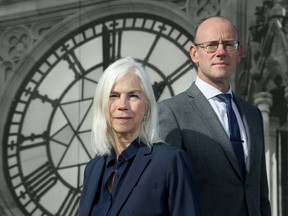Politics
Analysis Reveals Federal Cuts Will Disproportionately Impact Women and Minorities

Prime Minister Mark Carney’s upcoming cuts to the federal public service are set to disproportionately affect women, Indigenous communities, racialized individuals, and workers with disabilities, according to a new analysis from the Canadian Centre for Policy Alternatives published on October 20, 2023. The report estimates that approximately 59 percent of the job losses will impact women, while 5.5 percent will affect Indigenous employees, 26 percent will be racialized individuals, and 8.3 percent will involve workers with disabilities.
The analysis highlights that departments experiencing the most significant budget cuts are among the most diverse in the federal workforce. In contrast, organizations expected to face smaller reductions have less diverse employee representation. Economists David Macdonald and Katherine Scott, who authored the report, warned about the potential for widened employment and pay gaps, as well as a reduction in access to essential employment benefits.
In early July, the Carney administration initiated a spending review directing most federal departments and agencies to reduce their operational budgets by 15 percent over the next three years. This review could result in around 57,000 job losses across the federal government, as previously indicated by the Canadian Centre for Policy Alternatives.
Departments such as the Department of National Defence (DND), Canada Border Services Agency (CBSA), and the Royal Canadian Mounted Police (RCMP) will only see a 2 percent cut in their operational budgets during this period, as Carney has pledged to increase funding for defense and border security initiatives.
The analysis describes these agencies as “equity laggards,” noting that women constitute 43 percent of DND’s civilian workforce and 47 percent of CBSA’s staff. In stark contrast, the Employment and Social Development Canada (ESDC) workforce is approximately 67 percent female, with an estimated 3,915 women likely to lose their positions due to the cuts. Other departments such as Indigenous Services Canada (ISC), the Department of Justice, and the Public Health Agency of Canada (PHAC) also maintain a female workforce of around 70 percent, with potential job losses estimated at 918, 604, and 935 women, respectively.
Macdonald emphasized that women in the federal public sector often enjoy better job security and flexibility than their counterparts in the private sector, where significant wage gaps persist. “You see massive wage gaps in the private sector,” he stated.
The anticipated job losses will also adversely affect Indigenous workers. The report estimates that Indigenous employees will comprise approximately 5.5 percent of the job losses, slightly exceeding their current representation of 5.3 percent in the public service. Departments such as ISC, Crown-Indigenous Relations, and Correctional Service Canada, which have Indigenous workforces ranging from 11 percent to 27 percent, are projected to lose 359, 84, and 318 Indigenous employees, respectively.
Racialized workers make up 31 percent of the ESDC workforce and 41 percent of Immigration, Refugees and Citizenship Canada, both of which are likely to experience significant job losses. In contrast, only about 12 percent of DND’s workforce and 18 percent of RCMP employees are racialized.
Regarding workers with disabilities, approximately 7.8 percent of the federal workforce report having a disability. However, the analysis suggests that 8.3 percent of the positions expected to be eliminated will belong to employees with disabilities. Departments that have made the most progress in hiring these individuals, such as the Department of Justice, Department of Veterans Affairs, and the Department of Natural Resources, will face the highest cuts, with figures ranging from 10 percent to 20 percent of workers with disabilities. ESDC alone could see more than 500 jobs lost in this category.
Macdonald mentioned that there is hope for a reconsideration of the cuts to departments like ISC as the budget process unfolds. “It may well be, once they’ve looked at this, that they will come to their senses on some of these files,” he told the Ottawa Citizen.
Both Macdonald and Scott acknowledged that the federal government has historically been a leader in promoting “employment equity and proactive pay equity.” They highlighted that the gender pay gap is narrower in the public sector compared to the private sector, even after accounting for factors such as education and job tenure. However, the current cuts pose a significant threat to these advancements.
“The federal public service has been a counterweight to the private sector in terms of attempting to employ more women and more Indigenous workers,” Macdonald asserted, noting that these efforts would be jeopardized by the impending budget reductions.
The impact of these cuts extends beyond job loss; it threatens to erode the progress made toward equity in the workplace within the federal government. As the situation develops, it will be crucial to monitor the broader implications for diversity and inclusion across public service sectors.
-

 World3 months ago
World3 months agoScientists Unearth Ancient Antarctic Ice to Unlock Climate Secrets
-

 Entertainment3 months ago
Entertainment3 months agoTrump and McCormick to Announce $70 Billion Energy Investments
-

 Lifestyle3 months ago
Lifestyle3 months agoTransLink Launches Food Truck Program to Boost Revenue in Vancouver
-

 Science3 months ago
Science3 months agoFour Astronauts Return to Earth After International Space Station Mission
-

 Technology2 months ago
Technology2 months agoApple Notes Enhances Functionality with Markdown Support in macOS 26
-

 Top Stories1 week ago
Top Stories1 week agoUrgent Update: Fatal Crash on Highway 99 Claims Life of Pitt Meadows Man
-

 Sports3 months ago
Sports3 months agoSearch Underway for Missing Hunter Amid Hokkaido Bear Emergency
-

 Politics2 months ago
Politics2 months agoUkrainian Tennis Star Elina Svitolina Faces Death Threats Online
-

 Technology3 months ago
Technology3 months agoFrosthaven Launches Early Access on July 31, 2025
-

 Politics3 months ago
Politics3 months agoCarney Engages First Nations Leaders at Development Law Summit
-

 Entertainment3 months ago
Entertainment3 months agoCalgary Theatre Troupe Revives Magic at Winnipeg Fringe Festival
-

 Politics1 week ago
Politics1 week agoShutdown Reflects Democratic Struggles Amid Economic Concerns




















